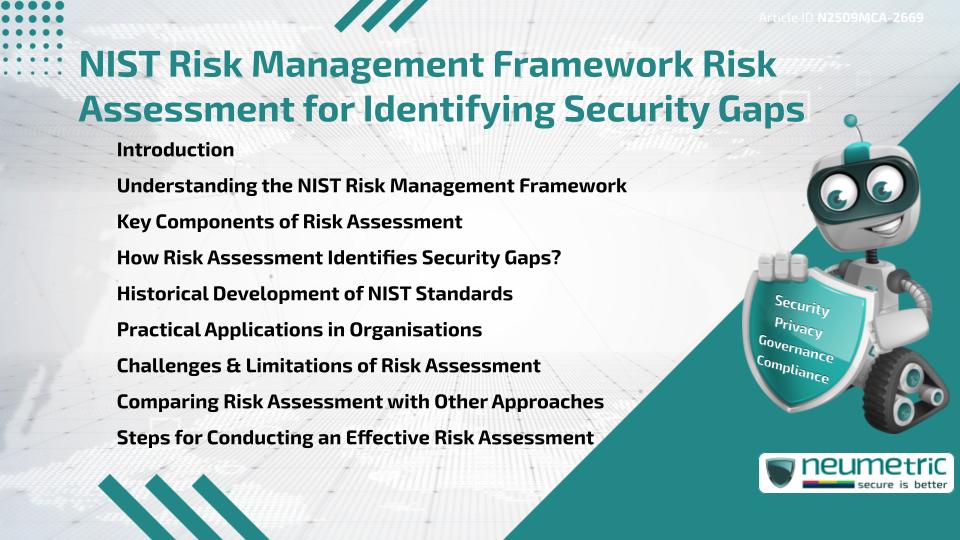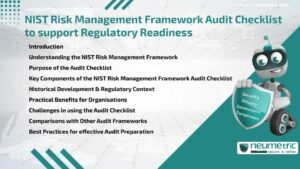Table of Contents
ToggleIntroduction
The Risk NIST Management Framework Risk Assessment provides a structured approach to identifying & addressing Security Gaps within an Organisation. This method helps businesses evaluate Risks, prioritise Vulnerabilities & implement protective measures to safeguard data & systems. By following a systematic Assessment process, Organisations can align with Compliance Requirements, reduce exposure to Cyber Threats & enhance overall resilience. This article explores the Framework, its historical background, practical applications & limitations while offering a clear perspective on how it identifies critical Security Gaps.
Understanding the NIST Risk Management Framework
The National Institute of Standards & Technology [NIST] developed the Risk Management Framework [RMF] to provide guidelines for managing Cybersecurity Risks. At its core, the Framework emphasizes Continuous Monitoring, thorough Risk evaluation & informed decision-making. The Risk NIST Management Framework Risk Assessment is a crucial component, ensuring that Organisations systematically evaluate Potential Threats & their impact on operations.
Key Components of Risk Assessment
The Risk Assessment process under the RMF involves several key steps:
- Identifying Potential Threats & Vulnerabilities
- Evaluating the Likelihood of exploitation
- Determining the impact of Risks on organisational assets
- Establishing controls to mitigate these Risks This structured approach ensures that security decisions are based on Evidence rather than assumptions.
How Risk Assessment Identifies Security Gaps?
Security Gaps often emerge when Vulnerabilities remain unaddressed. The Risk NIST Management Framework Risk Assessment highlights these gaps by mapping Threats against existing controls. For example, if outdated software lacks patches, the process flags it as a potential entry point for attackers. By exposing such weak points, Organisations can prioritise Corrective Actions & allocate resources effectively.
Historical Development of NIST Standards
NIST has been a cornerstone of Cybersecurity guidance since the early 2000s. Its frameworks evolved in response to increasing Cyber Threats & regulatory demands. The development of the RMF was driven by the need for a standardised, repeatable method for assessing Risks across both Government & private sectors. Over time, the Risk NIST Management Framework Risk Assessment became a trusted tool for aligning security practices with federal & Industry Standards.
Practical Applications in Organisations
Organisations use the RMF to guide decisions about technology investments, vendor relationships & internal Policies. For example, Financial institutions apply the Risk NIST Management Framework Risk Assessment to assess Data Protection measures, while Healthcare providers use it to safeguard Patient Records. Beyond compliance, the Framework supports Risk-based decision-making, helping leaders allocate resources to areas that matter most.
Challenges & Limitations of Risk Assessment
While the Framework is valuable, it is not without limitations. Risk Assessment outcomes depend heavily on the accuracy of data & the expertise of those conducting the evaluation. Some Organisations may find the process time-consuming or resource-intensive. Additionally, emerging Threats like zero-day attacks may not be fully addressed by traditional Assessment methods.
Comparing Risk Assessment with Other Approaches
Unlike generic checklists or ad-hoc reviews, the Risk NIST Management Framework Risk Assessment is Evidence-based & systematic. However, other models such as ISO 27001 or COBIT offer alternative perspectives. Comparing these approaches helps Organisations choose methods that align with their operational goals. While no Framework is perfect, RMF’s structured methodology is particularly effective at identifying overlooked Security Gaps.
Steps for Conducting an Effective Risk Assessment
To implement an effective Assessment, Organisations should:
- Define objectives & scope clearly
- Gather accurate asset & Threat data
- Analyze potential impacts & likelihoods
- prioritise Risks based on Evidence
- Implement & monitor Risk Mitigation measures This step-by-step process ensures that the Risk NIST Management Framework Risk Assessment remains practical & results-oriented.
Takeaways
- The Risk NIST Management Framework Risk Assessment provides a structured method to identify Security Gaps.
- It emphasizes Evidence-based evaluation of Threats & Vulnerabilities.
- Organisations can use the process to improve compliance & reduce cyber Risks.
- Limitations include resource demands & the challenge of addressing emerging Threats.
- Its systematic nature makes it more reliable than ad-hoc approaches.
FAQ
What is the purpose of the Risk NIST Management Framework Risk Assessment?
Its purpose is to identify, analyze & mitigate Cybersecurity Risks in a structured & repeatable manner.
How does it help in identifying Security Gaps?
It compares known Threats against existing controls, revealing Vulnerabilities where Security Measures are missing or insufficient.
Is the Framework mandatory for all Organisations?
While mandatory for federal agencies, private Organisations often adopt it voluntarily to strengthen security practices & align with Industry Standards.
What industries benefit most from using it?
Healthcare, Finance & Government agencies benefit significantly, but any sector handling Sensitive Data can leverage its advantages.
How often should a Risk Assessment be conducted?
It should be performed regularly, often annually or whenever significant changes in technology, systems or Threats occur.
What are the main challenges Organisations face with it?
Challenges include the time, expertise & resources required, as well as adapting to new & evolving Threats.
Can the Framework be used alongside other standards?
Yes, many Organisations integrate it with standards such as ISO 27001 or COBIT for a comprehensive approach to Risk Management.
Need help for Security, Privacy, Governance & VAPT?
Neumetric provides organisations the necessary help to achieve their Cybersecurity, Compliance, Governance, Privacy, Certifications & Pentesting needs.
Organisations & Businesses, specifically those which provide SaaS & AI Solutions in the Fintech, BFSI & other regulated sectors, usually need a Cybersecurity Partner for meeting & maintaining the ongoing Security & Privacy needs & requirements of their Enterprise Clients & Privacy conscious Customers.
SOC 2, ISO 27001, ISO 42001, NIST, HIPAA, HECVAT, EU GDPR are some of the Frameworks that are served by Fusion – a SaaS, multimodular, multitenant, centralised, automated, Cybersecurity & Compliance Management system.
Neumetric also provides Expert Services for technical security which covers VAPT for Web Applications, APIs, iOS & Android Mobile Apps, Security Testing for AWS & other Cloud Environments & Cloud Infrastructure & other similar scopes.
Reach out to us by Email or filling out the Contact Form…





